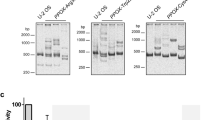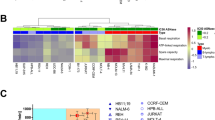Abstract
Succinyl acetone (SA) was initially identified in the urine of patients with tyrosinemia type I, an autosomally recessive inherited disease. SA has been used to downregulate the activity of myeloperoxidase (MPO) through its specific inhibition of heme biosynthesis and to investigate the biological properties of MPO in the human myeloid leukemic (HL-60) cell line. The goal of this study is to evaluate the mutagenic potential of SA by determining the frequencies of somatic mutations in the hypoxanthine-guanine phosphoribosyl transferase (HPRT) reporter gene in HL-60 cells following treatment with the chemical. Treatments of HL-60 cells with 500 μmol/L SA for 72 h, a condition generally used to inhibit the MPO activity, resulted in a significantly increased HPRT mutant frequency (HPRT-Mf), compared with the control of untreated cells (47.25 × 10-6 versus 7.5 × 10-6, respectively, p <0.01). Treatment of the cells with lower doses of SA also led to an increase in HPRT-Mf but this was significant only with 200 μmol/L (28.67 × 10-6, p<0.05) and not with doses lower than 100 μmol/L (p0.05), compared with the control of untreated cells (7.5 × 10-6). These data show a dose–response increase in HPRT-Mf in HL-60 cells treated with SA, suggesting that this chemical causes mutations in the HPRT locus in these cells either directly or indirectly through its inhibition of the MPO activity.
Similar content being viewed by others
Abbreviations
- 6-TG:
-
6-thioguanine
- ALA-D:
-
5-aminolevulinate dehydratase
- BPDE:
-
benzo[a]pyrene 7,8-diol-9,10-epoxide
- DMSO:
-
dimethyl sulfoxide
- FAA:
-
fumarylacetoacetate
- HPRT:
-
hypoxanthine-guanine phosphoribosyl transferase
- HPRT-Mf:
-
HPRT mutant frequency
- MPO:
-
myeloperoxidase
- SA:
-
succinylacetone
References
Bigbee WL, Day RD, Grant SG, et al. Impact of maternal lifestyle factors on newborns HPRT mutant frequencies and molecular spectrum—Initial results from the Prenatal Exposures and Preeclampsia Prevention (PEPP) Study. Mutat Res. 1999;431:279–89.
Cascorbi I, Henning S, Brockmuller J, et al. Substantially reduced risk of cancer of the aerodigestive tract in subjects with variant -G463A of the myeloperoxidase gene. Cancer Res. 2000;60:644–9.
Chang CS, Sassa S. Induction of 5-aminolevulinic acid dehydratase in mouse Friend virus-transformed erythroleukemia cells during erythroid differentiation. Blood 1984;64:64–70.
Clement MV, Ramalingam J, Long LH, Halliwell B. The in vitro cytotoxicity of ascorbate depends on the culture medium used to perform the assay and involves hydrogen peroxide. Antioxid Redox Signal. 2001;3:157–63.
Cook JA, Mitchell JB. Viability measurements in mammalian systems. Anal Biochem. 1989;179:1–7.
Ebert PS, Hess RA, Frykholm BC, Tschudy, DP. Succinyl acetone, a potent inhibitor of heme biosynthesis: effect on cell growth, heme content and 5-aminolaevulinic acid dehydratase activity of malignant murine erythroleukemia cells. Biochem Biophys Res Commun. 1979;88:1382–90.
Fidler JM, Chang TQ, Bauer R, Young JD, Vitt CR. Suppression of graft-versus-host disease by succinyl acetone in a rat allogeneic bone marrow transplantation model. Transplantation 1993;55:367–73.
Giger U, Meyer UA. Effect of succinylacetone on heme and cytochrome P450 synthesis in hepatocyte culture. FEBS Lett. 1983;153:335–8.
Gilbert-Barness E, Barness LA, Meisner LF. Chromosomal instability in hereditary tyrosinemia type I. Pediatr Pathol. 1990;10:243–52.
Grant SG, Chapman VM. Mechanisms of X-chromosome regulation. Annu Rev Genet. 1988;22:199–233.
Grompe M. The physiopathology and treatment of hereditary tyrosinemia type 1. Semin Liver Dis. 2001;21:563–71.
Henderson JP, Byun J, Takeshita J, Heinecke JW. Phagocytes produce 5-chlorouracil and 5-bromouracil, two mutagenic products of myeloperoxidase, in human inflammatory tissue. J Biol Chem. 2003;278:23522–8.
Hess RA, Tschudy DP, Blaese RM. Immunosuppression by succinylactone. II. Prevention of graft-vs-host disease. J Immunol. 1987;139:2845–9.
Jorquera R, Tanguay RM. The mutagenicity of the tyrosine metabolite, fumarylacetoacetate, is enhanced by glutathione depletion. Biochem Biophys Res Commun. 1997;232:42–8.
Jorquera R, Tanguay RM. Cyclin B-dependent kinase and caspase-1 activation precedes mitochondrial dysfunction in fumarylacetoacetate-induced apoptosis. FASEB J. 1999;13:2284–98.
Jorquera R, Tanguay RM. Fumarylacetoacetate, the metabolite accumulating in hereditary tyrosinemia, activates the ERK pathway and induces mitotic abnormalities and genomic instability. Hum Mol Genet. 2001;10:1741–52.
Kagan VE, Kuzmenko AI, Tyurina YY, Shvedova AA, Matsura T, Yalowich JC. Pro-oxidant and antioxidant mechanisms of etoposide in HL-60 cells: role of myeloperoxidase. Cancer Res. 2001;61:7777–84.
Kennelly JC, Clare CB, Campbell J, et al. The mutagenic activity of ethylmethanesulphonate, benzidine and benzo(a)pyrene at the hprt locus of wild-type L5178Y mouse lymphoma cells. Mutagenesis 1990;5(Supplement):21–6.
Kensese SM, Smith LL. Hydrogen peroxide mutagenicity towards Salmonella typhimurium. Teratog Carcinog Mutagen. 1989;9:211–8.
Keohavong P, Thilly WG. Mutational spectrometry: a general approach for hotspot point mutations in selectable genes. Proc Natl Acad Sci USA. 1992;89:4623–7.
Koeffler HP, Ranyard J, Pertcheck M. Myeloperoxidase: its structure and expression during myeloid differentiation. Blood 1985;65:484–91.
Le Marchand L, Seifried A, Lunn A, Wilkens LR. Association of the myeloperoxidase -463G->A polymorphism with lung cancer risk. Cancer Epidemiol Biomark Prev. 2000;9:181–4.
Lindblad B, Lindstedt S, Steen G. On the enzymic defects in hereditary tyrosinemia. Proc Natl Acad Sci USA. 1977;74:4641–5.
Manabe S, Sassa S, Kappas A. Hereditary tyrosinemia. Formation of succinylacetone–amino acid adducts. J Exp Med. 1985;162(3): 1060–74.
Mazur M, Glickman BW. Sequence specificity of mutations induced by benzo(a)pyrene-7,8-diol-9,10-epoxide at endogenous aprt gene in CHO cells. Somat Cell Mol Genet. 1988;14:393–400.
Mitchell GA, Grompe M, Lambert M, Tanguay RM. Hypertyrosinemia. In: Scriver CR, Beaudet AL, Sly WS, Valle D, eds. The Metabolic and Molecular Bases of Inherited Disease. New York: McGraw-Hill; 2001:1777–805.
Nauseef WM. Myeloperoxidase biosynthesis by a human promyelocytic leukemia cell line: insight into myeloperoxidase deficiency. Blood. 1986;67:865–72.
Nauseef WM, McCormick S, Yi H. Roles of heme insertion and the mannose-6-phosphate receptor in processing of the human myeloid lysosomal enzyme, myeloperoxidase. Blood. 1992;80:2622–33.
Oller AR, Thilly WG. Mutational spectra in human B-cells spontaneous, oxygen and hydrogen peroxide-induced mutations at hprt gene. J Mol Biol. 1992;228:813–26.
Phaneuf D, Lambert M, Laframboise R, Mitchell G, Lettre F, Tanguay RM. Type 1 hereditary tyrosinemia: evidence for molecular heterogeneity and identification of a causal mutation in a French Canadian patient. J Clin Invest. 1992;90:1185–92.
Pinnix IB, Guzman GS, Bonkovsky HL, Zaki SR, Kinkade JM Jr. The post-translational processing of myeloperoxidase is regulated by the availability of heme. Arch Biochem Biophys. 1994;312:447–58.
Raff RF, Storb R, Graham T, et al. Pharmacologic, toxicologic, and marrow transplantation studies in dogs given succinyl acetone. Transplantation. 1992;54:813–20.
Reynolds WF, Chang E, Douer D, Ball ED, Kanda V. An allelic association implicates myeloperoxidase in the etiology of acute promyelocytic leukemia. Blood. 1997;90:2730–7.
Sassa S, Kappas A. Succinyl acetone inhibits delta-aminolevulinate dehydratase and potentiates the drug and steroid induction of delta-aminolevulinate synthase in liver. Trans Assoc Am Physicians. 1982;95:42–52.
Schabath MB, Spitz MR, Zhang X, Delcros GL, Wu X. Genetic variants of myeloperoxidase and lung cancer risk. Carcinogenesis. 2000;21:1163–6.
Skolik SA, Palestine AG, Blaese RM, Nussenblatt RB, Hess RA.Treatment of experimental autoimmune uveitis in the rats with systemic succinylacetone. Clin Immunol Immunopathol. 1988;49:63–71.
Tanguay RM, Jorquera R, Poudrier J, St-Louis M. Tyrosine and its catabolites: from disease to cancer. Acta Biochim Pol. 1996;43:209–16.
Tschudy D, Hess R, Frykholm B. Inhibition of 5-aminolevulinic acid dehydratase by 4,6-dioxoheptanoic acid. J Biol Chem. 1981;256:9915–23.
Tschudy DP, Hess RA, Frykholm BC, Blaese RM. Immunosuppressive activity of succinylactone. J Lab Clin Med. 1982;99:526–32.
Wagner BA, Buettner GR, Oberley LW, Darby CJ, Burns CP. Myeloperoxidase is involved in H2O2-induced apoptosis of HL-60 human leukemia cells. J Biol Chem. 2000;275:22461–9.
Weinberg A, Mize C, Worthen H. The occurrence of hepatoma in the chronic form of hereditary tyrosinemia. J Pediatr. 1976;88:434–8.
White RD, Krumperman PH, Cheeke PR, Buhler DR. An evaluation of acetone extracts from six plants in the Ames mutagenicity test. Toxicol Lett. 1983;15:25–31.
Whiteman M, Spencer JP, Jenner A, Halliwell B. Hypochlorous acid-induced DNA base modification: potentiation by nitrite: biomarkers of DNA damage by reactive oxygen species. Biochem Biophys Res Commun. 1999;257:572–6.
Xu L-L, Liu G, Miller DP, et al. Counterpoint: the myeloperoxidase -463G->A polymorphism does not decrease lung cancer susceptibility in caucasians. Carcinogenesis. 2002;11:1555–9.
Zerbini C, Weinberg DS, Hollister KA, Perez-Atayde AR. DNA ploidy abnormalities in the liver of children with hereditary tyrosinemia type I. Correlation with histopathologic features. Am J Pathol. 1992;140:1111–9.
Ziegler-Skylakakis K, Andrae U. Mutagenicity of hydrogen peroxide in V79 Chinese hamster cells. Mutat Res. 1987;192:65–7
Author information
Authors and Affiliations
Corresponding author
Rights and permissions
About this article
Cite this article
Zheng, KC., Yalowich, J.C., Kagan, V.E. et al. Increased mutant frequencies in the HPRT gene locus of leukemia HL-60 cells treated with succinylacetone. Cell Biol Toxicol 22, 361–370 (2006). https://doi.org/10.1007/s10565-006-0171-4
Received:
Accepted:
Published:
Issue Date:
DOI: https://doi.org/10.1007/s10565-006-0171-4




